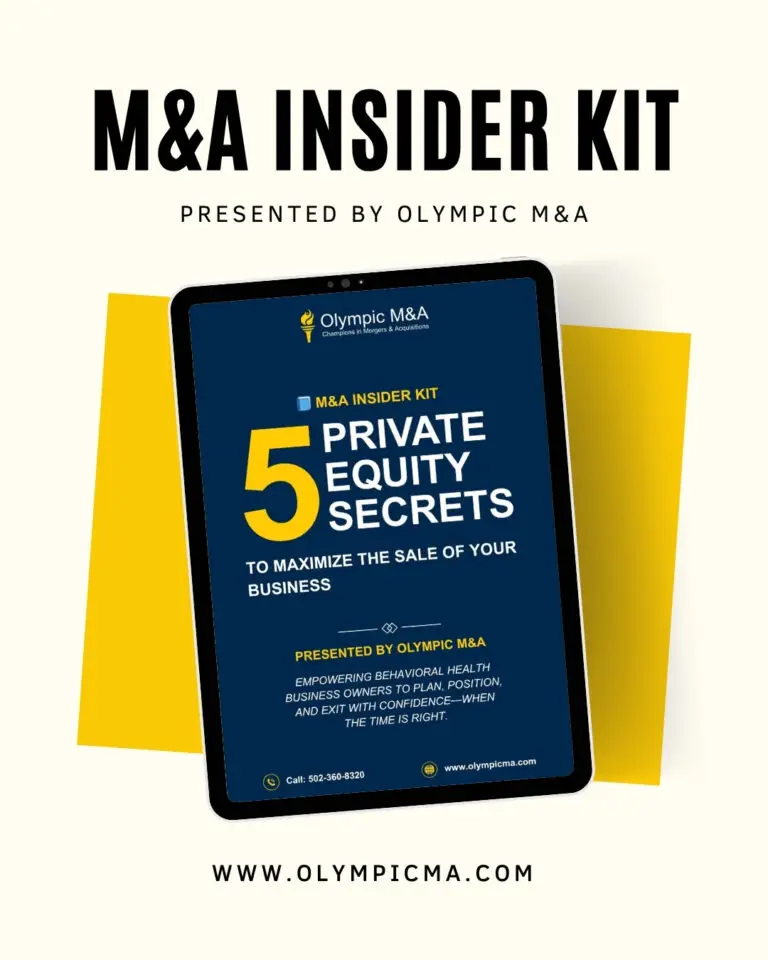Employee Assistance Programs (EAPs) are gaining attention from private equity firms and strategic buyers seeking to expand in behavioral health. As demand grows for workplace mental health services, investors see EAPs as recurring-revenue businesses with scalable value.
Still, many EAP owners aren’t sure what buyers prioritize—or how to position their business to command a strong offer.
📘Want to understand how private equity buyers really evaluate and structure deals in the EAP space?
Download our free guide: “5 Private Equity Secrets: How to Maximize the Sale of Your EAP Business.”It reveals the inside playbook investors use—and how you can prepare to gain leverage.
At Olympic M&A, we recently helped an EAP owner close a deal that significantly exceeded early offers—adding over seven figures in additional value. Here’s what buyers are really looking for.
1. Long-Term Employer Contracts
Buyers place a premium on employer relationships—especially those with government or enterprise clients. They look for:
- Multi-year contracts with high renewal rates
- A diverse client base across industries
- Minimal customer concentration risk
Strong contracts signal revenue predictability and lower buyer risk.
2. Financial Performance and EBITDA
Historically, EAPs have sold for 1.0x to 1.4x revenue, but many buyers are now using EBITDA multiples—a major shift that benefits well-managed businesses.
Buyers focus on:
- Consistent margins and clean books
- Year-over-year growth
- Clear separation of personal and business expenses
Strong EBITDA performance drives more competitive valuations and financing options.
3. Operational Efficiency
Buyers favor scalable, well-run businesses that are easy to integrate. Key considerations include:
- Internal vs. outsourced clinical teams
- Billing, scheduling, and documentation systems
- Compliance with HIPAA and regulatory standards
The more efficient the operation, the stronger the valuation.
4. Leadership and Transition Plan
If the owner is central to daily operations, buyers see risk. On the other hand, businesses with second-tier leaders or a clear post-sale transition plan are more attractive.
- Is there a clinical or operational lead in place?
- Is the owner willing to stay on for a transition period?
- Are SOPs and responsibilities well-documented?
Continuity builds buyer confidence and reduces deal risk.
5. Integration Potential
Buyers often plan to integrate EAPs into broader behavioral health platforms. Businesses that use modern systems and provide employer-facing reporting tools are easier to plug into existing networks.
This improves strategic value—and can increase purchase price.
Avoidable Red Flags
Common issues that hurt value include:
- Overreliance on one or two clients
- Owner-dependent operations
- Weak financial records or compliance protocols
- Lack of tracking around renewals, utilization, or ROI
These challenges don’t always kill a deal—but they do lower offers and increase friction.
How to Prepare Now
If you’re considering a sale in the next 12–24 months:
- Clean up your financials and client contracts
- Build leadership depth or formal SOPs
- Upgrade compliance systems and reporting
- Get a confidential valuation and buyer-readiness review
Even minor improvements can add meaningful value.
Final Thoughts
Buyers are actively pursuing EAP businesses—but they’re selective. By understanding what drives value and preparing accordingly, owners can maximize outcomes and attract multiple offers.
Olympic M&A recently helped an EAP owner unlock a substantial seven-figure gain by focusing on the right metrics and strategic positioning.
To learn more about preparing your EAP business for sale and navigating private equity transactions, download our free “5 Private Equity Secrets” guide here.
For a confidential conversation about your options, contact Tony Siebel at 502.360.8320 or email tonys@olympicma.com. Connect with Tony on LinkedIn: linkedin.com/in/tonysiebel









